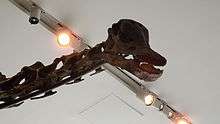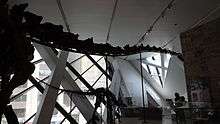Gordo (dinosaur)

"Gordo", as the Barosaurus at the Royal Ontario Museum (ROM) is known, is one of the most complete examples of the Barosaurus in North America (another one can be found at the American Museum of Natural History in New York).[1] This specimen is over 90 feet (27 m) long and is on display in the James and Louise Temerty Galleries of the Age of Dinosaurs.[2]
In 1912, a Carnegie excavation team unearthed three nearly complete Barosaurus skeletons in a quarry in Utah.[3] The quarry has become part of the Dinosaur National Monument Fossil Quarry, where a number of complete dinosaur specimens have been unearthed since its discovery in 1909. There are many layers of the fossil quarry, some of the earliest dating to 144 million years ago and over 70 tons of material was collected from the site for the Pennsylvania Carnegie Museum..

Around 1962, one specimen from the Pennsylvania collection was transferred to the Royal Ontario Museum in Toronto, Canada, to be included in their new dinosaur gallery.[4] Once it arrived it was put into storage, as the museum had run out of floor space in the gallery.[5] There is sat for the next 40 years. In 2007, curator David Evans was on the hunt for an example of a sauropod (a group of dinosaurs including Barosaurus) to add to the ROM's collection when he read an article about a specimen in storage at the ROM. What Evans found was a nearly complete fossil of the Barosaurus. Today, the specimen is a centerpiece in the dinosaur exhibit.

References
- ↑ Museum Secrets. . The History Channel. (retrieved October 2013)
- ↑ Evans, David. "Iconic Must See Treasures of the ROM" . Royal Ontario Museum. (retrieved October 2013)
- ↑ Tucciarone, Joe. Barosaurus (retrieved October 2013)
- ↑ CTV.ca News Staff (2007). ROM to unveil rare dino bones found in basement.
- ↑ Switek, Brian (2011). The Rediscovery of Gordo the Barosaurus Smithsonian Institution. (retrieved October 2013)